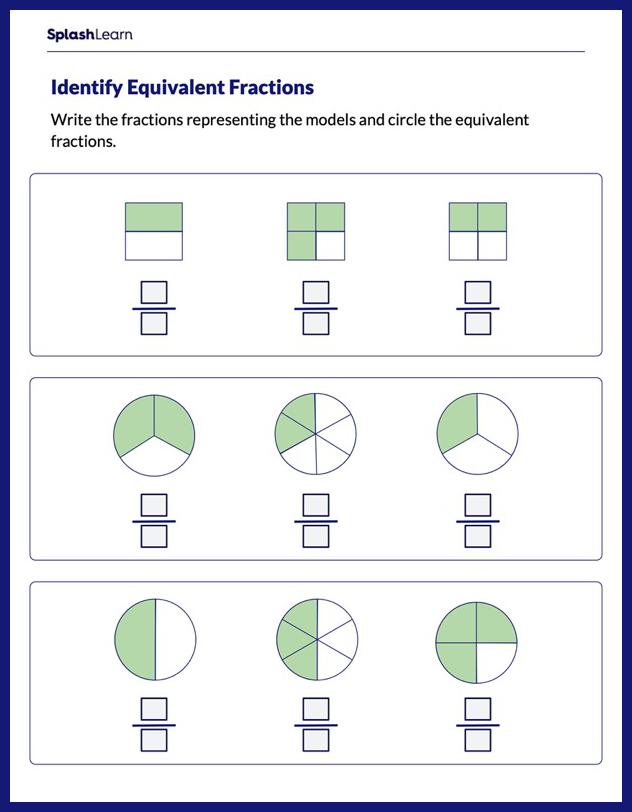What is a Unit Circle in Math?
A unit circle is a circle of unit radius with center at origin. A circle is a closed geometric figure such that all the points on its boundary are at equal distance from its center. For a unit circle, this distance is 1 unit, or the radius is 1 unit.
Let us learn the equation of the unit circle, and understand the ways to represent each of the points on the circumference of the unit circle, with the help of T-ratios.
Recommended Games
Unit Circle: Definition
The unit circle is a circle with a radius of one unit.
The unit circle is fundamentally related to the concepts of trigonometry. The trigonometric functions can be defined using the unit circle.
A unit circle on the Cartesian plane is shown below. It has its center at origin and all the points on the circumference are at a distance of 1 unit from the center.
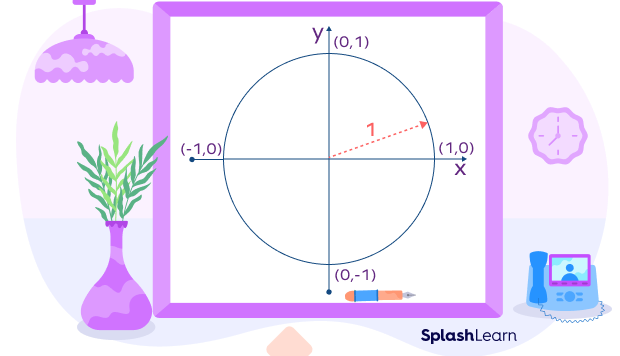
Recommended Worksheets
Equation of a Unit Circle
The general equation of a circle is of the form $(x \;-\; a)^2 + (y \;-\; b)^2 = r^2$, where the center of the circle is (a, b) and the radius is r. A unit circle in the x-y plane is formed with a center at origin (0,0) and radius 1.
Thus, the equation $(x \;-\; a)^2 + (y \;-\; b)^2 = r^2$ becomes
$(x \;-\; 0)^2 + (y \;-\; 0)^2 = 1^2$
$ x^2 + y^2 = 1$
Thus, the equation of the unit circle on an x-y plane is $x^2 + y^2 = 1$.
Finding Trigonometric Functions Using a Unit Circle
We can find trigonometric ratios using the unit circle. Consider the right triangle constructed in the unit circle shown in the diagram below.
Let P(x,y) be any point on the circle such that the line joining the origin and the point P makes angle with the positive x-axis. The radius of the circle (length = 1 unit) represents the hypotenuse of the right triangle. So, the sides of the right triangle are 1, x, y.
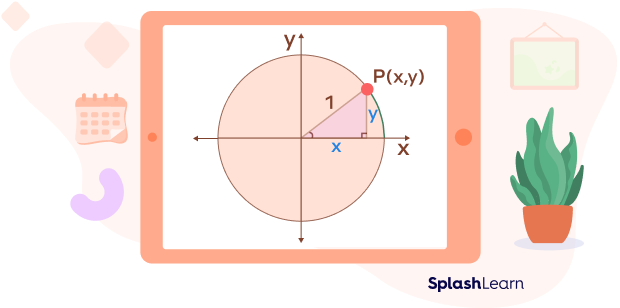
By the definition of the trigonometric ratios, we have
$sin\; \theta = \frac{Opposite\; Side}{Hypotenuse} = \frac{y}{1}$
$\Rightarrow y = sin\theta$
$cos\; \theta = \frac{Adjacent\; Side}{Hypotenuse} = \frac{x}{1}$
$\Rightarrow x = cos\theta$
Thus, $P(x,y) = P(cos\theta ,\; sin\theta )$
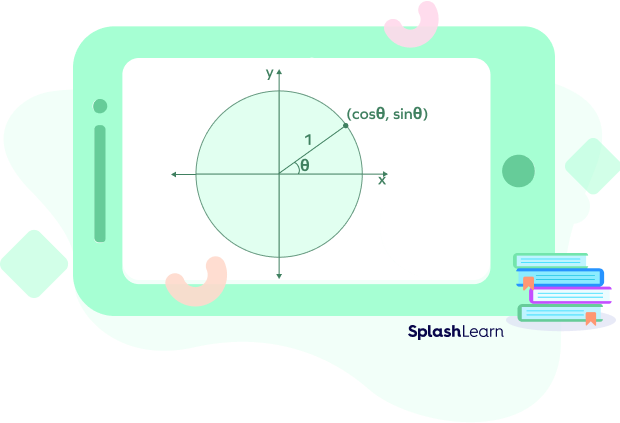
Unit Circle with Sin, Cos, and Tan
We just learnt that coordinates of any point on the unit circle are equal to $(cos\; \theta,\; sin\; \theta )$.
Thus, $x = cos\; \theta$ and $y = sin\; \theta$
Using these values, we can further calculate $tan\; \theta = \frac{sin\; \theta}{cos\; \theta}$
Example: Find the value of tan $60^\circ$ using sin and cos values from the unit circle.
We know that, tan$ \;60^{\circ} = \frac{sin\; 60^\circ}{cos\; 60^\circ}$
Refer to the unit circle chart. We get the values
$sin\; 60^\circ = \frac{1}{2}$
$cos\; 60^\circ = \frac{\sqrt{3}}{2}$
Therefore, tan $60^\circ = \frac{1}{2}\frac{\sqrt{3}}{2}$
tan $60^\circ = \frac{1}{3}$
Unit Circle and Trigonometric Values
The unit circle can be used to find all the trigonometric values. Let’s see some examples.
When $\theta = 0^\circ$, we have $x = 1$ and $y = 0$.
Thus,
$x = cos\; \theta = cos\; 0^\circ = 1$
and
$y = sin\; \theta = sin\; 0^ \circ = 0$
Similarly, for $= 45^\circ$
$x = cos\; 45^\circ = \frac{1}{\sqrt{2}}$ and $y = sin\; 45^\circ = \frac{1}{\sqrt{2}}$.
If a right triangle is placed in a unit circle in the cartesian coordinate plane, with hypotenuse, base, and altitude measuring 1, x, y units respectively, then the unit circle identities can be given as,
- $sin\;(\theta) = y$
- $cos\;(\theta) = x$
- $tan\;(\\theta) = \frac{sin\; \theta}{cos\; \theta} = \frac{y}{x}$
- $sec\;(\theta) = \frac{1}{x}$
- $cosec\;(\theta) = \frac{1}{y}$
- $cot\;(\theta = \frac{cos\; \theta}{sin\; \theta} = \frac{x}{y}$
In the next section, we will look at the unit circle with radians and unit circle degrees.
Unit Circle and Pythagorean Identities
Let us observe how we derive these unit circle equations considering a unit circle.
A point on the unit circle can be represented by the coordinates $cos\; \theta$ and $sin\; \theta$ .
Here, $x = cos\; \theta,\; $y = sin\; \theta$.

- The sides of the right triangle in the unit circle have the values of $sin\; \theta$ and $cos\; \theta$.
Applying the Pythagorean theorem, we can write $x^2 + y^2 = 1$
Substitute x and y, we get-
$sin^2\; \theta + cos^2 \;\theta = 1$
This equation is known as Pythagorean Identity.
It is true for all the values of $\theta$ in the unit circle.
- Using this first Pythagorean Identity, we can find the rest of the Pythagorean Identities.
$sin^2\; \theta + cos^2\; \theta = 1$
Dividing each term by $cos^2 \theta$
$\frac{sin^2\;\theta}{cos^2\;\theta} + \frac{cos^2\;\theta}{cos^2\;\theta} = \frac{1}{cos^2\;\theta}$
$tan^2\; \theta + 1 = sec^2\;\theta$
This is the second Pythagorean Identity.
- Now, on dividing each term of first equation by $sin^2\; \theta$, we get
$\frac{sin^2\; \theta}{sin^2\;\theta} + \frac{cos^2\;\theta}{sin^2\;\theta} = \frac{1}{sin^2\;\theta}$
$1 + cot^2\; \theta = cosec^2\theta$
This is the third Pythagorean Identity.
Unit Circle Chart in Radians and Degrees
The unit circle chart in radians is given in the diagram below. It represents a total angle of 2 radians or 360.
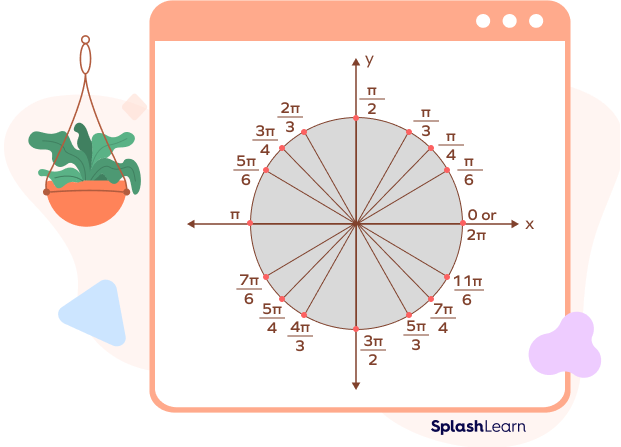
The unit circle is divided into four quadrants by the intersection of x-axis and y-axis. The points which represent the angles $\frac{\pi}{0},\; \frac{\pi}{6},\; \frac{\pi}{4},\; \frac{\pi}{3},\; \frac{\pi}{2}$ are the standard values of the trigonometric cosine and sine ratios.
The diagram shows unit circle values in both radians and degrees.
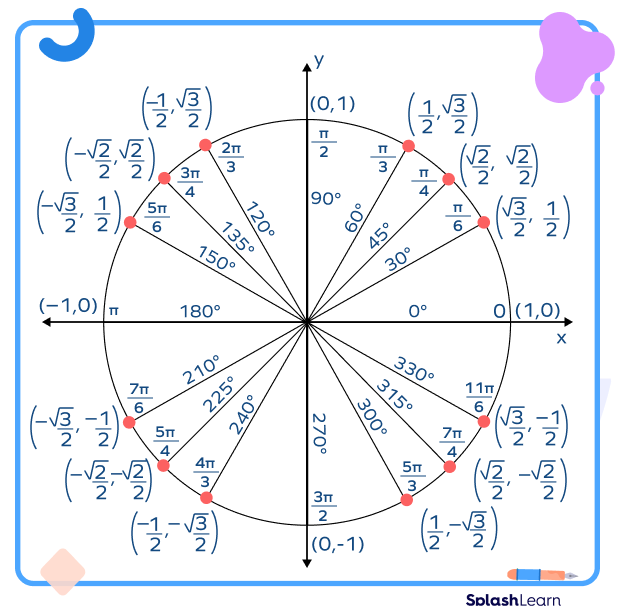
Unit Circle and Trigonometric Values
The unit circle can be used to find the various trigonometric identities and their principal angle values. Let’s see some examples.
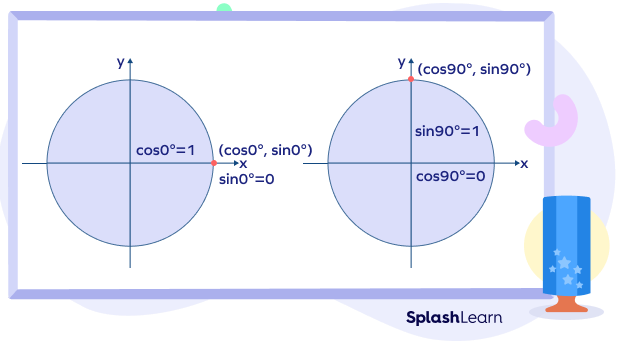
When $= \theta\; 0^\circ$, we have $x = 1$ and $y = 0$.
$x = cos\; \theta = cos\; 0^\circ = 1$
$y = sin\; \theta = sin\; 0^\circ = 0$
Similarly, for $\theta = 45^\circ$
$x = cos 45^\circ = \frac{1}{\sqrt{2}}$ and $y = sin\; 45^ = \frac{1}{\sqrt{2}}$.
Let us now look at another angle of $90^\circ$.
Here, the value of cos $90^\circ = 1$, and sin $90^\circ = 1$.
Unit Circle Table
The unit circle table helps to list the coordinates of the points on the unit circle and corresponding common angles using trigonometric ratios.
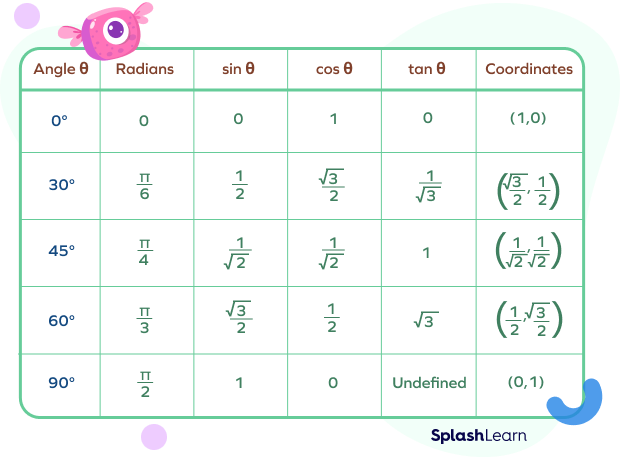
The table above can be used as a unit circle calculator. We can find the rest of the ratios, namely secant, cosecant, and cotangent functions using the given formulas:
$sec\; \theta = \frac{1}{cos\; \theta}$
$cosec\; \theta = \frac{1}{sin\; \theta}$
$cot\; \theta = \frac{1}{sin\; \theta}$
Conclusion
In this article, we discussed unit circle and its properties. We saw some properties of trigonometry. And along with the concept of trigonometry, we solved T-ratios. We studied the unit circle chart. We solved many problems related to it.
Solved Examples on Unit Circle
1. Does the point A $( \frac{1}{4},\; \frac{1}{4})$ lie on the unit circle?
Solution:
We know that equation of a unit circle is:
$x^2 + y^2 = 1$
Substituting $x = \frac{1}{4}$ and $y = \frac{1}{4}$ , we get:
$= x^2 + y^2$
$= \frac{1^2}{4} + \frac{1^2}{4}$
$= \frac{1}{16} + \frac{1}{16}$
$= \frac{2}{16}$
$= \frac{1}{8}$
$\neq 1$
Since, $x^2 + y^2 \neq 1$ , the point A $(\frac{1}{4},\;\frac{1}{4})$ does not lie on the unit circle.
2. Does the point A $(\frac{1}{8},\; \frac{1}{8})$ lie on the unit circle?
Solution:
We know that equation of a unit circle is:
$x^2 + y^2 = 1$
Substituting $x = \frac{1}{8}$ and $y = \frac{1}{8}$ , we get:
$= x^2 + y^2$
$= \frac{1^2}{8} + \frac{1^2}{8}$
$= \frac{1}{64} + \frac{1}{64}$
$= \frac{2}{64}$
$= \frac{1}{32}$
$\neq 1$
Since, $x^2 + y^2 \neq 1$ , the point A $(\frac{1}{8},\; \frac{1}{8})$ does not lie on the unit circle.
3. If $sin\; \theta + cos\; \theta = \frac{2}{3}$, what is $sin\; \theta.\; cos\; \theta$?
Solution:
Given $(sin\; \theta + cos\; \theta) = \frac{2}{3}$
Squaring both sides,
$(sin\; \theta + cos\; \theta)^2 = (\frac{2}{3})^2$
$sin^2\;\theta + cos^2\; \theta + 2\; sin\; \theta\; cos \theta = \frac{4}{9}$
$1 + 2\; sin\; \theta\; cos\; \theta = \frac{4}{9}$
$2\; sin\; \theta\; cos\; \theta = (\frac{4}{9}) \;-\; 1 = \frac{- 5}{9}$
$sin\; \theta\; cos\; \theta = \frac{-5}{18}$
4. If $sin\; \theta = \frac{4}{5}$, find the value of $cos\; \theta$.
Solution:
Here, we use the identity $sin^2\; \theta + cos^2\; \theta = 1$
$(\frac{4}{5})^2 + cos^2\; \theta = 1$
$cos\; \theta = \sqrt{1\;-\; (\frac{4}{5})^2} = \sqrt{\frac{9}{25} = \frac{3}{5}}$
5. What is the area of a unit circle?
Solution:
The unit circle has radius $= 1$ unit.
$Area = \pi r^2$
$Area = \pi\; square\; units$
Practice Problems on Unit Circle
Unit Circle - Definition, Chart, Equation, Examples, Facts
What is the Equation of a Unit Circle?
The equation of a unit circle is $x^2 + y^2 = 1$.
What is the value of cos $180^\circ$ using the unit circle chart?
From the unit circle chart, we know that:
$x = -1$ and $y = 0$.
Thus, $x = cos\; 180^\circ = -1$
The radius of the unit circle is __________.
The unit circle has radius 1 unit.
What is the value of tan $270^\circ$ using the unit circle?
We know that
$tan\; 270^\circ = \frac{sin\; 270^\circ}{cos\; 270^\circ}$
Using the unit circle chart:
$sin\; 270^\circ = -1$
$cos\; 210^\circ = 0$
Therefore, $tan\; 270^\circ = -10 =$ undefined
Does the point A $(2 , 2)$ lie on the unit circle?
We know that equation of a unit circle is:
$x^2 + y^2 = 1$
Substituting $x = 2$ and $y = 2$, we get:
$= x^2 + y^2$
$= 2^2 + 2^2$
$= 4 + 4$
$= 8$
$\neq 1$
Since, $x^2 + y^2 \neq 1$, the point A $(2, 2)$ does not lie on the unit circle.
Frequently Asked Questions on Unit Circle
What is the tangent of a circle?
A line that touches the circle at one point is called a tangent to the circle.
The intersecting point at which the tangent touches the circle is known as its point of contact.
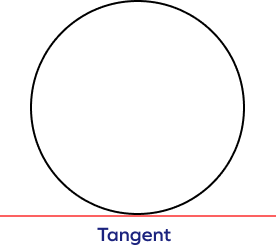
What are the applications of trigonometry?
Trigonometry is used in various fields like astronomy, oceanography, electronics, navigation, etc.
What is the radius of a unit circle?
The radius of a unit circle is 1 unit.
What is the unit circle with tangent?
The unit circle gives the values of sine and cosine function. However, the unit circle with tangent gives the values of the tangent function or tan function for different angles between 0 and 360 degrees.


























